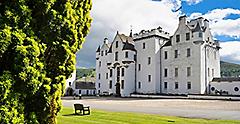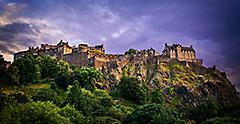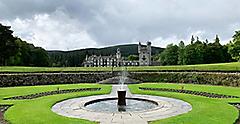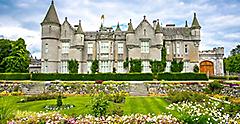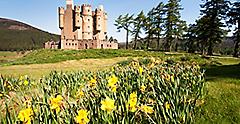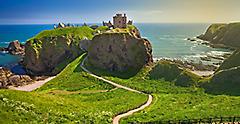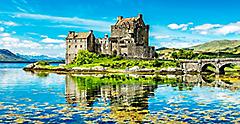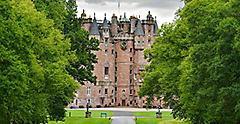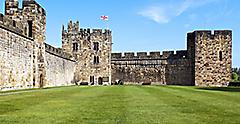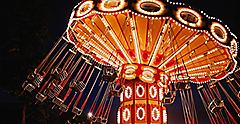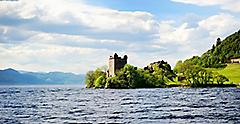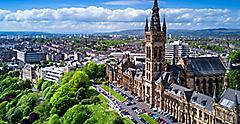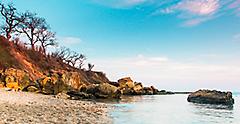Ahh, Scotland; the kilts, the rolling highlands, the bagpipes, the whiskey … what's not to love? If you've seen the popular series "Outlander," you'll know exactly what I mean. And if not, prepare yourself, because the real Scotland is more poetically dramatic than any prime-time TV series.
Castles are a staple of Scottish history and culture, and there are plenty of Scotland castle tours to choose from on your visit to the country for some cultural tourism. Each one has its epic saga to tell, unique architecture to share and a rich culture not usually found in the modern world. While some are private, many castles are open to the public. Millions of visitors from around the world come to admire their grandeur. Whether standing atop a rocky cliff or nestled in green hills of waving heather, these towering piles always evoke a sense of wonder.
Today, Scotland castle tours remain an important window into Scottish heritage and history. Whether you're interested in learning more about kings and queens gone by or just looking for some beautiful scenery to add to your Scotland tours, here are some of the most famous castles to visit in Scotland.
The History Of Scottish Castles
Scottish castles can be traced back to the 12th century when the French Norman knights invaded England. King David I, the youngest son of Malcolm III and Queen Margaret, was so impressed by Norman rule that, as king of Scotland, he commissioned the Normans to build castles pretty much everywhere. He was also the first Scottish King to live in Edinburgh (but more on that later!).
Back in the 1100s, castles were the height of technology. While a stone arch may look pretty basic, a lot went into it in the days before power tools and backhoes. First, a talented stone worker had to hew the rocks down to the correct size with accurate angles. Then, a builder had to place the medieval blocks to balance them together. To top it all off, the lead architect had to know how to build a structure that would withstand weather and attack. Of course, castles also needed to be built on a defensible position (such as a hill or cliff) and required considerable funds to build and maintain. Construction could take multiple generations!
Most castles standing today were built between the 12th and 16th centuries—not only as defensive structures but also as symbols of power and prestige. A few castles around Scotland are even still owned and inhabited by the founders' descendants.
Scottish nobility fought constantly for control over land. While there was plenty of fighting between the clans, there was also a massive clash with the English during the 13th and 14th centuries. The bloody War of Independence that ensued united Scots in their desire to break away from English rule. During this time, castles were a vital asset. They protected from enemy attacks and were an excellent base to launch raids on rival clans.
The Scots have a reputation for being a feisty bunch who won't say no to a good fight. And back in medieval days, that was truer than ever. In the Battle of Flodden, the bloodiest battle in British history, the Scottish side lost 10,000 men. While many nations' war stories will place heroic emphasis on one person — looking at you, Napoleon — Scottish history more often celebrates the entire family or clan, proclaiming that each person is as brave as the next.
Take Famous Royal Scotland Castle Tours
Not only are castles steeped in legend and folklore, but they are uniquely popular with the public thanks to their strong ties to royalty. Rich history, incredible artifact collections and current royal use make some Scottish castles more famous than others.
Edinburgh Castle is, without a doubt, the place to visit if you only have time to see one castle when you cruise to Edinburgh. As one of the oldest fortified places in Europe, it's situated atop a rocky hill that looms over the city. The ground where it stands was used for strategic positioning as early as the Iron Age and is the most besieged place in Britain.
The sprawling building has a complex history of additions and renovations. Considering the number of sieges and leadership changeovers it has witnessed, there's plenty to discover. The castle's story began in 1093 when Queen Margaret (later made St. Margaret) died, and her son King David I built the intimate St. Margaret's Chapel in her honor. The next addition was built some 300 years later by King James IV. His Great Hall was a place for lavish banquets and Scottish state events, and today, its bright red walls are adorned with an arsenal of Scottish weaponry. Unfortunately, his brother-in-law, King Henry VIII of England, put a quick end to those banquets when his English forces killed James IV two years later at the Battle of Flodden. Talk about family grudges!
There are many historic rooms and lookout points to explore in Edinburgh castle: the Half Moon Battery, James VI's Birth Chamber in the Royal Palace, Argyle Tower, the Crown Jewels of Scotland and the daring Lang Stairs are all worthy spots. I recommend picking up an audio tour and choosing a guided itinerary to get the most out of your experience and see why Edinburgh has the best walking castle tours in Scotland.
Balmoral: The Royal Summer Home
Immerse Yourself In The Arts In Stirling Castle
Wrapping up the list of royal hotspots is Stirling Castle, one of the most important sites you can visit on your trip to Scotland. Along with Edinburgh castle, this castle is one of the most frequent hosts to royals, and the walls practically burst with Scottish culture. Mary Queen of Scots was crowned here at just nine months old — she threw a crying fit through the entire ceremony!
There's plenty to see, but when inside Stirling castle, I knew what my priorities were. I made a beeline for the Royal Palace chambers, eager to see one of the most impressive recreations of medieval tapestry art. Hung in these chambers are replicas of the Hunt of the Unicorn tapestries. They cost £2 million to recreate and are absolutely stunning. James V commissioned two sets of tapestries that depicted unicorns — a national emblem of Scotland.
All in all, Stirling Castle makes for a most entertaining visit with plenty of interactive displays, tour guides in full costume and visual re-imaginings of castle life. At night, the castle hosts Shakespearean plays, light shows and other events.
Castle Tours That Celebrate Scottish Culture
When it comes to travel destinations, I'm partial to the hidden, mysterious or forgotten. And while many of Scotland's epic castles still attract millions of tourists, some are less frequented than others. I recommend you see at least one of these gems to truly connect with the wild Scottish countryside for a vacation story like no other.
While other castles may impress you with their size, Braemar Castle wows with its sheer architectural ingenuity. The top-heavy castle stands above the Highlands on a small hill, surrounded by a grove. Walking up to it, you can just imagine the sense of foreboding it struck in approaching enemies.
Originally, Braemar castle was built as a hunting lodge for the Earls of Mar, some of Scotland's earliest rulers. But in 1715, the 6th Earl fled the country after losing a rebellion, and Braemar castle was seized by the crown and eventually bought by the Farquharsons of Invercauld. When the uprisings, rebellions and battles eventually died down in 1830, the Farquharson family turned the castle into a peaceful countryside retreat that has since hosted a slew of famous visitors. In 2007, the small local community took over care of the castle. The site is currently undergoing a massive renovation project that should be completed in late 2023. If you arrive before then, you'll have to make do with the spectacular exterior view.
Visit Macbeth And A Hogwarts Castle Tour In Scotland
Come For The Architecture, Stay For The Magic
The list of potential castle activities to check out on your vacation to Scotland goes beyond architecture tourism. Book a cruise to Inverness and play a round of nine-hole golf at the magnificent Cawdor castle, or enjoy a tipple while surveying the rugged landscape and loch at Inveraray castle. You could walk through generations of artifacts and eclectic military architecture at Blair castle. And you definitely could go hunting for the shy Loch Ness monster hiding in the waters surrounding Urquhart Castle. With over 1,500 castles in Scotland, there really is no shortage of sites to explore.
Castles have a long and storied history in Scotland, playing an important role in the country's journey to the modern age. Today, many of these castles are open for cultural tourism. Explore their grand halls, learn about their fascinating past and pretend you're in a fantasy novel.
Get Royal Deals, Sign Up Today

Getting There
Explore Our Most Affordable Itineraries
Book a British Isles cruise and experience the magic of Scotland.


